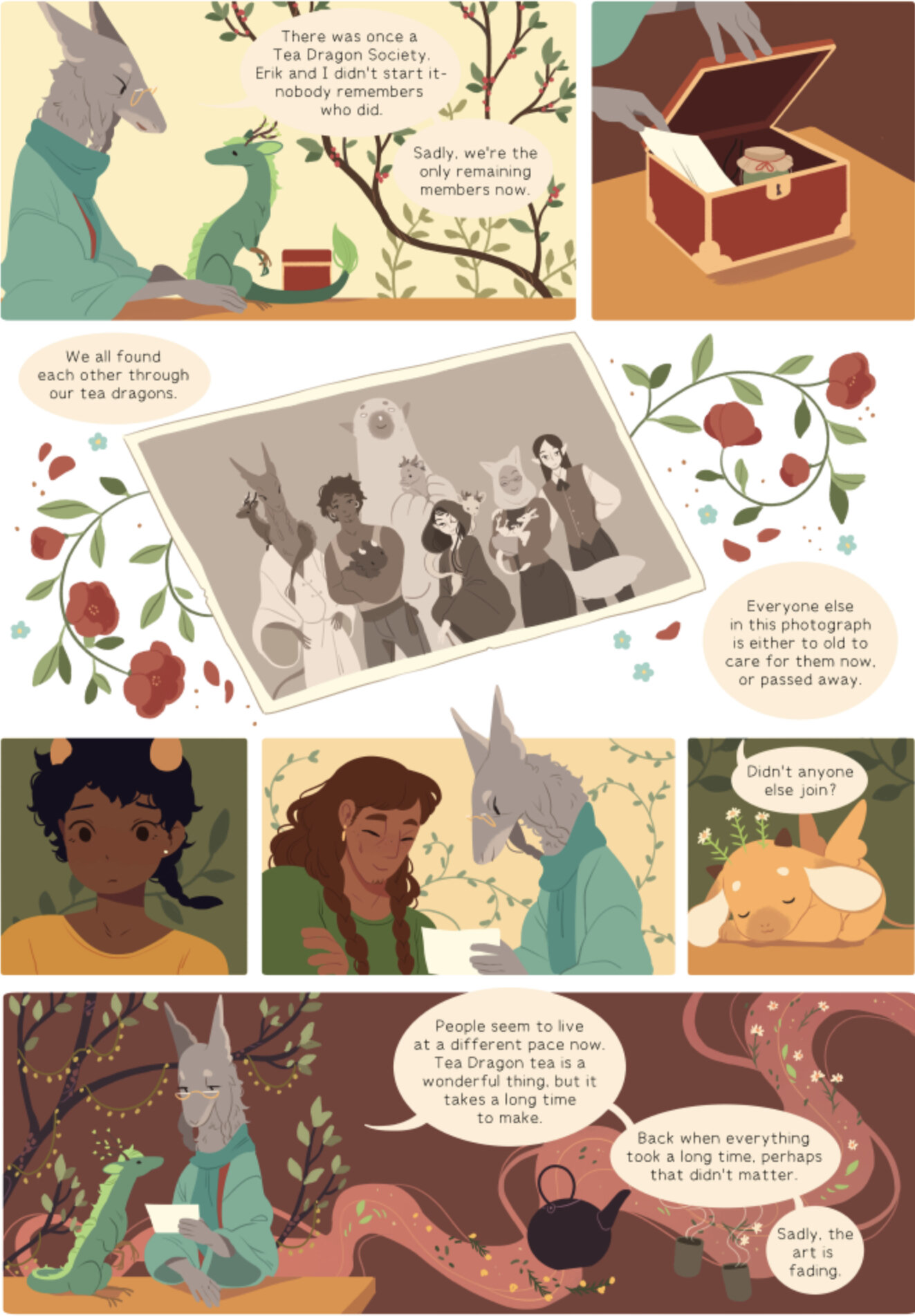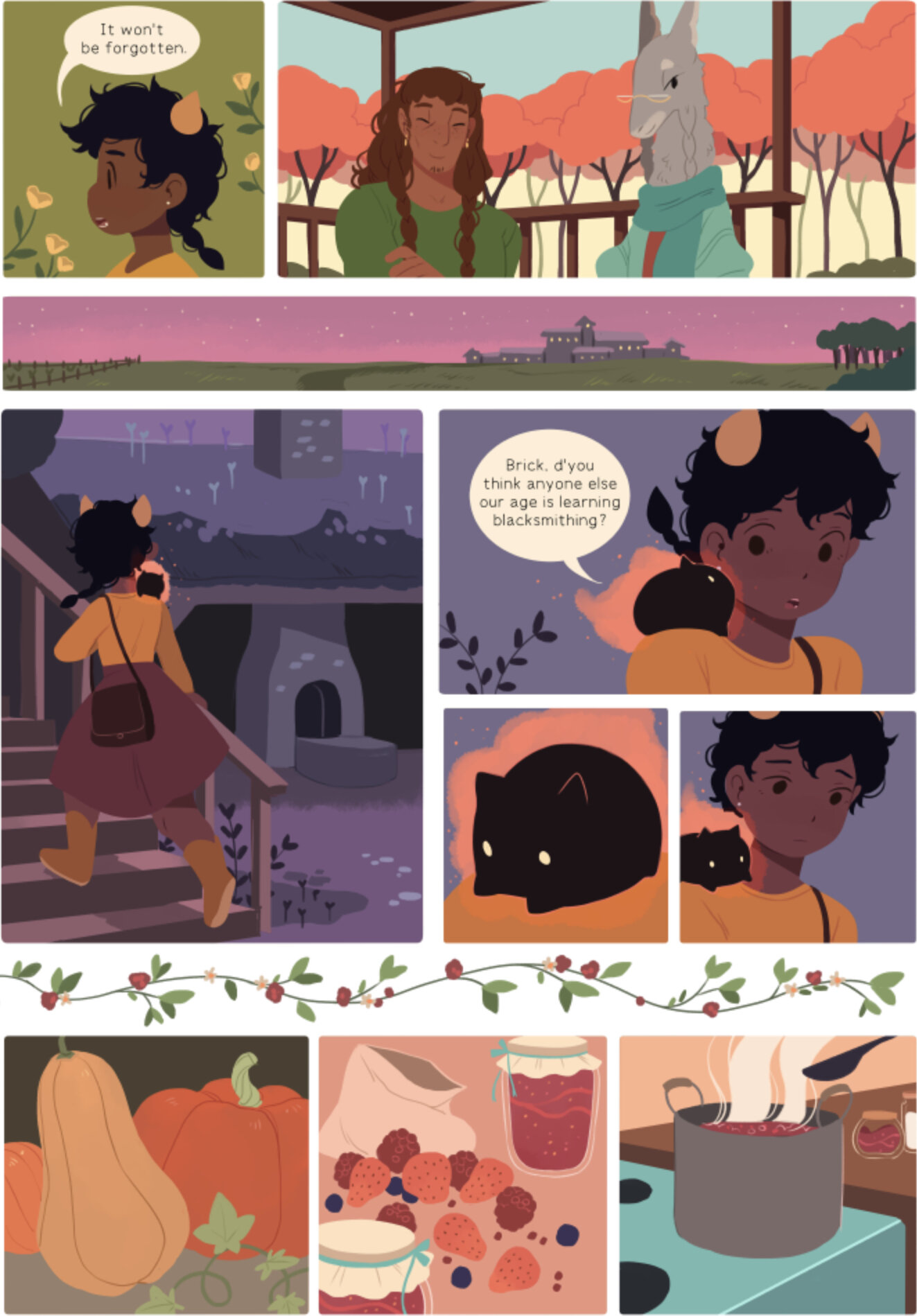The Tea Dragon Society is a comic short story created by Katie O’Neill. Greta is a blacksmith apprentice who struggles with finding purpose in a craft that doesn’t seem appreciated anymore. Her questioned is eventually answered when she meets Hezekiel and Erik, the last remaining members of the Tea Dragon Society, a group who takes care of the rare miniature dragons that sprout tea from their bodies. Greta also becomes close the forgetful and bashful Minette, who also has her own tea dragon. All three of them show Greta the importance of community and taking care of those around you.
What does the Tea Dragon Society achieve by fostering a queer community?
The most immediate answer is that the Society provides its members with a chosen family. This is a topic that has been discussed before, but plenty of topics are worth reexamining in different contexts. In short, chosen families are an essential part of the queer community as they they provide the love and support that, sadly, many queer people cannot receive from the family they grew up with. The are a safe space for complete and unconditional acceptance that even those that come from accepting families need because queer people are united by a deep, shared experience that non-queer people will never be able to fully identify with. Through these chosen families, the queer community has been able to keep itself safe and continue nurturing its children. What do these families look like from the outside, though? Many of them are groups of friends that have been brought together by serendipity alone; others are public-facing queer groups like sports teams, music groups, artist collectives… and others might not necessarily start off as a card-carrying queer group, but they bring together people that share something unique and uncommon but nonetheless real and valid.
Credit: Katie O’Neill
A seven-panel page.
First panel: Hezekiel is sitting at the table, with Jasmine sitting in front of him on the table.
Hezekiel: There was one a Tea Dragon Society. Erik and I didn’t start it - nobody remembers who did. Sadly, we’re the only remaining members now.
Second panel: A close-up of Hezekiel pulling out a white piece of paper from a small chest.
Third panel: A close-up of a black and white photo of a group of six people holding their tea dragons. The photo is set against a backdrop of red flowers on a vine.
Hezekiel (off-panel): We all found each other through our tea dragons. Everyone else in this photograph is either too old to care for them now, or passed away.
Fourth panel: A close-up of Greta looking sad.
Fifth panel: Erik and Hezekiel are huddled close over the photo, happily reminiscing.
Sixth panel: A close-up of Chamomile curled up, sleeping.
Greta (off-panel): Didn’t anyone else join?
Seventh panel: To the left side of the panel, Hezekiel is at the table looking closely at the picture in his hand, with Jasmine on his hind legs peering up at him. As a backdrop and towards the right side of the panel, there’s a tree with illustrations of a tea kettle and cups surrounded by jasmine flowers and leaves on a pink wave of aroma.
Hezekiel: People seem to live at a different pace now. Tea dragon tea is a wonderful thing, but it takes time to make. Back when everything took a long time, perhaps that didn’t matter. Sadly, the art is fading.
The Tea Dragon Society, as a group, seems to offer more than a safe space for its members. It also seems to be more than a club where people can easily come and go. What sets this group apart and that really resonates to the core of the queer experience is the establishment of a legacy. Culture is created with several generations’ worth of time, with people repeating and passing along objects, knowledge, and rituals from one generation to the next. This is easy to see in national cultures: their manner of speaking, cooking, celebrating, and creating art are widely known and preserved because of the sheer size of the group in question. For minority groups, especially those that have been historically oppressed, this is much harder to achieve. Consider that the queer community has existed throughout history in secluded pockets of society, so some aspects of their legacy exist. However, the AIDS crisis of the 1980s took a harrowing toll on countless lives and extinguished countless stories to share and voices to be heard.
Credit: Katie O’Neill
A ten-panel page.
First panel: A close-up of Greta, looking determined.
Greta: It won’t be forgotten!
Second panel: Erik and Hezekiel against a background of red trees and a blue sky. They look at Greta, both pleased and confident.
Third panel: A long panel featuring the skyline of Greta’s town at dusk.
Fourth panel: Greta is walking up the stairs while looking at her family’s forge.
Fifth panel: A close-up of Greta talking to Brick on her shoulder.
Greta: Brick, d’you think anyone else our age is learning blacksmithing?
Sixth panel: A close-up of Brick looking down in thought.
Seventh panel: A close-up of Greta, crest fallen, and Brick.
Eighth panel: A group of pumpkins and squashes.
Ninth panel: A bag of berries and two jars full of jam.
Tenth panel: A pot full of simmering jam.
The established world in The Tea Dragon Society is certainly not as grim but, like any other object, it wasn’t conceived in a bubble. While the world seems to be accepting of couples like Hezekiel and Erik, and children like Greta and Minette feel comfortable expressing their affection for each other, it doesn’t mean that the community doesn’t worry about its future. Both Hezekiel and Erik worry that the legacy of tea dragons will be lost in this new age, which isn’t just the knowledge and skills needed to nurture the dragons, but also the stories and lives of the previous members brought together by their queer hobby. This is the narrative line for Greta’s character: understanding that legacy is important and worth preserving because of the service it provides to the community as a whole. Blacksmithing creates objects that people need and cherish; tea dragon tea allows people to grow closer and fosters empathy; and the Society isn’t just a club but a family of like-minded people. Hezekiel and Erik come to understand that their fears and worries of their legacy being lost is assuaged by fostering and nurturing younger generations in safe spaces; and Greta learns that legacies, such as smithing, tea growing and jam making, can be gifted forward for the betterment and care of the community.

